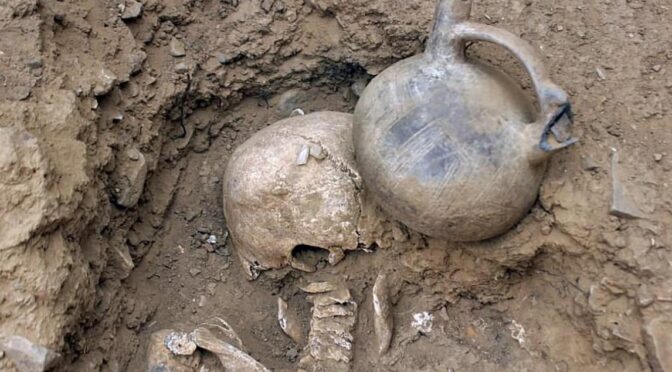Archaeologists find 3,000-year-old megalithic temple in Peru
A 3,000-year-old ancient temple has been discovered in Peru by a team of Peruvian archaeologists, who think it may have been used by pagans for ‘rituals of water worship’.
The religious monument is over 131ft long and is located in the springs of the Zaña Valley river about 500miles from Lima, the modern capital of Peru.
Inside the temple archaeologists found a square with an alter that was likely used to offer important fertility rituals with water taken from the Zaña Valley river.

The megalith structure was found at the Huaca El Toro site in the Lambayeque region of Peru by a team led by Walter Alva, the archaeologist who discovered the tomb of the Lord of Sipan in 1987.
The temple still features the remains of large stone blocks and a long staircase. ‘This discovery is unique because it is the only megalithic architecture in Lambayeque,’ said Dr Alva.
The site was discovered in October 2021 but the news of its finding was delayed to reduce the risk of treasure hunters taking artefacts that hadn’t been secured.
The temple comes from a time when water was considered divine and was used in a number of rituals and religious practices, researchers claim.

They were able to determine this temple was home to a cult that worshipped water by studying the way they alter is positioned and how it looks.
The altar includes holes similar to those found in other temples from the period. ‘This is typical of water altars that are in other places, and it is located in the springs of the Zaña Valley river’, Mr Alva said.
Mr Alva said they have identified a circular column, where evidence of sedimentation of rains and rituals was found.
‘This temple is facing the mountain. This place is strictly ceremonial because of the signs of burning that took place.’
‘The rituals were performed for fertility,’ he said. Stunning walls surround the monument and there is a central staircase that is 32ft wide and 49ft long.
The Peruvian team discovered 21 tombs on the site of the temple which is thought to date back to about 1,500 BC to 292 AD.
Inside the tombs, they found ceramic pieces and metal objects such as knives that were placed next to the graves.

Mr Alva says it is likely the tombs were later reused as 20 burial sites were from the later Inca Chimu culture which dates back to about 1,000 to 1,470 AD.
This isn’t the first major discovery made by Walter Alva and his team.
The archaeologist also discovered the tomb of the Lord of Sipan in 1987. Sipan was a ruler of Mochica culture and his remains were found intact in Northern Peru.
In 2007 he discovered a number of 4,000-year-old murals in Peru. They show a deer caught in a net and are thought to be the oldest murals in the Americas.
